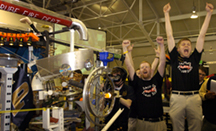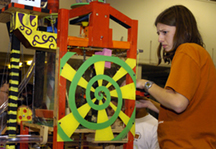
| VIDEO |
| • Shawn Jordan, co-captain of the Purdue team, describes some of the difficulties in completing the contest's task. (22 seconds) |
| RELATED INFO |
| • Theta Tau Fraternity | • Rube Goldberg Machine Contest |
Purdue's Rube Goldberg three-peat takes national spotlight
WEST LAFAYETTE, Ind. – Purdue University scored its third consecutive win in today's (Saturday, April 9) National Rube Goldberg Machine Contest with a machine that took 125 steps to turn on a flashlight.

|
Using steps that included launching a toy rocket and a rotating auger, the Purdue Society of Professional Engineers beat teams from six other universities to capture the national crown in complexity and inefficiency.
Teams in the competition, which took place in the Purdue Armory on the university's West Lafayette, Ind., campus, had to create machines that would replace batteries in a flashlight and turn it on using a minimum of 20 steps that employed principles of engineering and physics. While all of the teams used more than required, the winning machine's 125 steps were by far the most.
"We are all engineering and technology students, and this machine ties together everything we have learned in our classes," said co-captain Shawn Jordan, a graduate student in computer engineering from Fort Wayne, Ind. "It serves as a giant interdisciplinary design project that everyone on the team brings a different background and perspective to."
The group also won the event's People's Choice Award, which was voted on by the more than 400 audience members. A team from Ferris State University came in second with a carnival-themed machine, and the University of Texas at Austin placed third.

|
It was the third year in a row that a Purdue team won the national competition. Last year's winner was the Society of Manufacturing Engineers, and Theta Tau fraternity and Phi Sigma Ro sorority won in 2003.
Machines in the competition had three tries to successfully complete the task twice. Teams lost points if they manually assisted their machine during a run. Purdue Society of Professional Engineers team co-captain Kevin Hollingsworth said team members had spent the month between the March 5 local contest and the national event tweaking the machine so that it was more reliable. It was the only machine that did not have to use all three rounds to complete two successful runs.
"You spend most of your time trying to get the last 1 percent of things to work," said Hollingsworth, a senior in the School of Aeronautics and Astronautics from Zionsville, Ind. "Because the machines are built out of junk, they are inherently unreliable. The most important part of building a machine is making those last few pieces of junk reliable."
The winning machine told the story of rocket being launched. As the rocket traveled into space, a meteor hit Earth and started a fire. While the mock fire was put out, the rocket turned on the flashlight to shine back down on Earth.
In addition to Hollingsworth and Jordan, Purdue team members are Jason Downey, a junior in nuclear engineering from Idaville, Ind.; Nathan Flatt, a sophomore in mechanical engineering from Martinsville, Ind.; Greg Henning, a senior in aeronautics and astronautics from Indianapolis; Ryan Harold, a junior in mechanical engineering from Wheeling, Ill.; Devin Keeler, a senior in civil engineering from Randolph, N.J.; Maggie Little, a graduate student in the College of Technology from Crestview Hills, Ky.; Robert Mann, a sophomore in civil engineering from Fort Wayne, Ind.; Andy Mehl, a senior in electrical and computer engineering from Goshen, Ind.; and Drew Wischer, a sophomore in aviation technology from Manitowoc, Wis.
Other universities represented by teams were the University of Arizona, University of Michigan, Michigan State University and University of Toledo.
Arizona and University of Michigan were competing for the first time, and Theta Tau national contest chairman Greg Wilson said the addition of new teams is one of the contest's strengths.
"When teams from a new university start participating, they bring in new ideas and approaches," said Wilson, a junior in the School of Aeronautics and Astronautics from Fort Wayne, Ind. "That keeps everyone more creative, and you can tell from the quality and creativity of the machines this year."
The national Rube Goldberg Machine Contest was organized by the Phi Chapter of Theta Tau Fraternity at Purdue. Representatives from contest sponsors Motorola, General Electric and BAE Systems judged the machines. Other sponsors were Fluor, Lockheed Martin, Parker Hannifin, and the Purdue College of Engineering and School of Technology.
The contest honors the late cartoonist Rube Goldberg, who specialized in drawing whimsical, complicated machines to perform simple tasks. The student-built machines are judged on completion of the task, creativity, the number of steps involved and how well they embrace the Rube Goldberg spirit. Teams also are judged on the creative use of materials and related themes.
In previous contests, students' machines have been required to raise, secure and wave an American flag; select, clean and peel an apple; make a cup of coffee; toast a piece of bread; put a stamp on an envelope; and drop a penny into a piggy bank. Winners have appeared on "The Late Show with David Letterman," CBS' "This Morning," ABC's "Good Morning America," NBC's "Today," "Newton's Apple" and CNN.
Rube Goldberg and the Rube Goldberg Machine Contest are the trademark and copyright of Rube Goldberg Inc.
Writer: Matt Holsapple, mholsapple@purdue.edu
Sources: Kevin Hollingsworth, kholling@purdue.edu
Shawn Jordan, ssjordan@purdue.edu
Purdue News Service: (765) 494-2096, purduenews@purdue.edu
PHOTO CAPTION:
Kevin Hollingsworth, from left, of Zionsville, Ind., and teammate Shawn Jordan, of Fort Wayne, Ind., celebrate their machine's successful run during the 18th annual national Rube Goldberg Machine Contest, which took place today (Saturday, April 9) on Purdue University's West Lafayette, Ind. campus. Purdue's Society of Professional Engineers team took first place and won the People's Choice Award at the event, which also featured teams from the University of Texas at Austin, Ferris State University, Michigan State University, University of Arizona, University of Toledo and University of Michigan. The competition pays homage to the late cartoonist Rube Goldberg, who specialized in drawing whimsical machines with complex mechanisms to perform simple tasks. This year's contest required teams to build machines that could remove two batteries from a flashlight, replace them and then turn on the flashlight. While the competition required a minimum of 20 steps to complete the task, this year's winning machine used 125 steps. (Purdue News Service photo/David Umberger)
A publication-quality photo is available at https://ftp.purdue.edu/pub/uns/+2005/rube-nat05winner.jpg
PHOTO CAPTION:
Erin Miller of the University of Texas at Austin works on resetting her team's machine during the 18th annual national Rube Goldberg Machine Contest, which took place today (Saturday, April 9) on Purdue University's West Lafayette, Ind., campus. The University of Texas team took third place at the event, which also featured teams from Purdue, Ferris State University, Michigan State University, University of Arizona, University of Toledo and University of Michigan. The Purdue team took first place and won the People's Choice Award in the competition, which pays homage to the late cartoonist Rube Goldberg. Goldberg specialized in drawing whimsical machines with complex mechanisms to perform simple tasks. This year's contest required teams to build machines that used a minimum of 20 steps to remove two batteries from a flashlight, replace them and then turn on the flashlight. (Purdue News Service photo/David Umberger)
A publication-quality photo is available at https://ftp.purdue.edu/pub/uns/+2005/rube-nat05tex.jpg
To the News Service home page